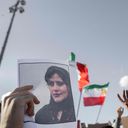Defiance spreads in Iran despite crackdowns

Supreme Leader Ali Khamenei broke his silence Monday after 17 days of protests in Iran, saying the death of Mahsa Amini was heartbreaking but claiming without evidence the ensuing "riots" had been instigated by the U.S. and Israel.
The big picture: Amini, 22, died after being detained by morality police for "improper hijab," the mandatory head covering. A viral image of her lying in a hospital bed fueled outrage, and protests that began at her funeral in Iran's Kurdistan province have swept through the country.
- The protesters have taken up the rallying cry of "woman, life, freedom," while some have chanted "death to the dictator," referring to Khamenei. Students and members of Iran's long-marginalized Kurdish minority have been particularly vocal.
- Police claimed Amini was not mistreated and that she died of a heart attack. Her family claims she had no health conditions and was beaten.
- Videos have spread widely of women and girls marching through cities waving or burning their headscarves, or defiantly turning up to schools without wearing them.
- Iranian authorities have responded with targeted internet shutdowns, teargas and in some cases lethal force. The death toll stands at 133, according to Iran Human Rights, a Norway-based NGO. Iranian state TV put the number at 41, including police.
Driving the news: Sunday was supposed to be the first day of classes at Tehran's prestigious Sharif University of Technology, but dozens of students gathered instead to protest.
- Security forces flooded into campus, firing tear gas and paintball pellets as the students attempted to flee, before making arrests.
- "What you see from Iranian authorities is clearly an attempt to subdue protests through sheer force," says Assal Rad of the National Iranian American Council. They're not heeding the calls of the people. They're not giving an inch."
State of play: The protesters have adjusted accordingly, says Mahsa Alimardani, a senior researcher on Iran at the human rights group Article 19.
- "Tehran is heavily securitized, but the protests are in little pockets throughout the city," Alimardani says. "So it's no longer everyone gathering in one boulevard at night, it's apartment blocks doing chants or three or four people gathering on a bridge."
- While the demonstrators are building on previous major protests in 2019 and 2009, this time around they're being led by women and in particular by Gen-Z, Alimardani says, though people of various ages and socioeconomic backgrounds have joined in.
- Several high-profile musicians and sports stars inside Iran have also spoken out, despite the risk of arrest.
What to watch: Analysts have debated whether the protests pose a genuine threat to the 43-year-old theocratic regime.
- A sizable portion of the population, though perhaps not a majority, supports the state and will be inclined to likely believe Khamenei's claims that the protests were instigated from abroad, Rad says. Pro-regime counter-protests have also been organized.
- "I think for the majority, that messaging will not work because they are simply aware of the fact that these are legitimate grievances," Rad adds.
- But the events may change Iran even if they don't change the government, says Alimardani. "After the stand they've made here, there's really no going back."
Go deeper: Iran protests spark wider adoption of anti-censorship tools
Editor's note: This story has been updated with additional context from Rad.